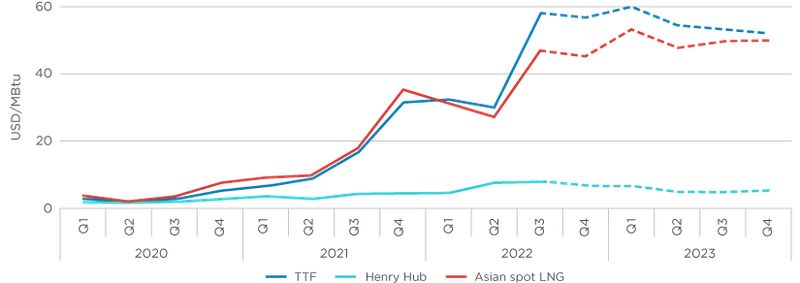The European Commission warned in September 2022 that
“the next winters – not just this one – will be
difficult, make no mistake about that”.1 In this
article, Joe Perkins 2 and Clemence Rainaut review the
various interventions governments made to support households and
businesses. Future energy support schemes should better meet the
twin objectives of providing support for essential use,
particularly by vulnerable groups, and maintaining effective
signals for reducing demand over time.
Introduction
In the short term, prices play two central roles in the
operation of a market:3
- First, they affect the distribution of surplus between the
sellers of a good and its consumers. Other things equal, when
prices rise, suppliers receive more of the surplus, and consumers
less. - Second, they help to balance supply and demand within a market.
Higher prices tend to increase supply and reduce demand, while
lower prices have the opposite impact.
If the first role of prices has been central to recent
discussions of energy market dynamics in Europe, the second role of
prices, in balancing supply and demand in a market, has been
largely overlooked. We discuss in this article how this could make
interventions significantly less effective, or much more expensive,
than would otherwise be the case.
Responding to high energy prices
There has been an unprecedented increase in energy prices since
2020. Most European countries rely heavily on gas, which is the
primary driver of the recent power price increase. This is because
gas-fired power stations are typically the marginal generators of
electricity, so their production costs drive power prices. In
Europe, third-quarter 2022 Dutch gas prices (TTF) were more than
eight times their five-year average. Asian spot liquefied natural
gas (LNG) prices rose in Q3 2022 to their highest quarterly level
on record (Figure 1). In Europe and Asia, forward curves as of the
end of September 2022 expected prices to remain at high levels in
2023.
Figure 1: Main spot and forward natural gas prices,
2020-2023
Source: IEA, Gas Market Report, Q-4 2022
In these circumstances, governments across Europe have
intervened to reduce the impact of energy price rises on households
and businesses. Higher energy prices can have dramatic effects on
consumers’ disposable incomes and well-being. Moreover, poorer
households tend to spend a greater proportion of their incomes on
energy than richer ones, making impacts on the poorest groups
particularly severe. Governments’ concerns have also grown
about small businesses and about inflation, which has exceeded 10%
for the first time in decades in several European
countries.4
While there has been some moderation in prices recently, the
supply disruption following Russia’s invasion of Ukraine is
likely to last. The European Commission warned in September 2022
that “the next winters – not just this one – will
be difficult, make no mistake about that”.5
It is therefore important to review the various interventions
governments have made to support households and businesses. Their
efficacy varies. As do their secondary effects, including on the
price of energy and the costs faced by government. There are likely
to be ongoing challenges in coming winters to ensure that support
schemes are well prepared to cover core consumption, especially for
vulnerable consumers, while allowing price mechanisms to help
balance supply and demand.
The effects of a supply reduction
It is helpful first to consider the effects of a negative shock
to energy supply on prices and profits, without intervention.
Figure 2 illustrates the relationship between prices and quantities
in an energy market. The curve S1 shows the supply curve
before a shock; this aggregates the short-term marginal costs of
energy suppliers. The curve S2 represents the supply
curve after a negative shock, such as a cut-off in Russian supplies
of gas. For any given price of energy, there is less supply
available. The curve D represents the demand of energy
consumers.
Figure 2: The effects of a supply reduction
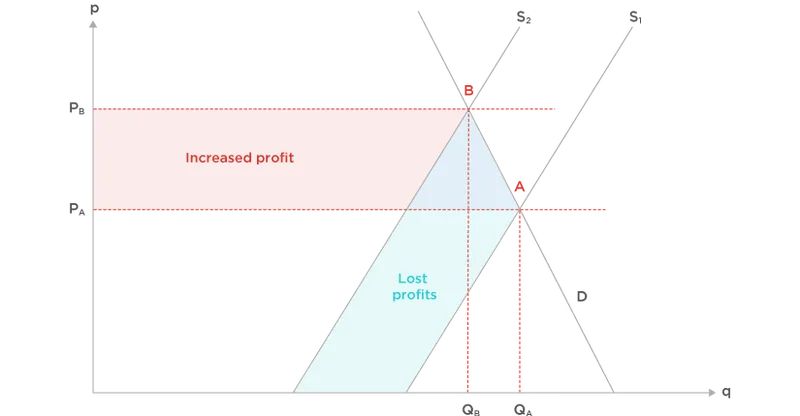
Both supply curves are upward sloping – production
increases as prices increase – while the demand curve is
downward sloping, because consumers reduce their demand at higher
prices. However, demand and supply curves are quite steeply sloped.
This is due to the expectation that energy supply and demand are
relatively inelastic in the short term. Energy producers cannot
quickly increase their production levels, while many energy
consumers cannot reduce their demand without significant
hardship.6
The supply shock moves market equilibrium from point A to point
B. Quantities sold fall from QA to QB, while
prices rise from PA to PB. If we assume that
firms were making normal profit levels before the supply shock, the
red shaded area illustrates the increase in profits (what we might
call “windfall” profits 7) due to the supply
shock, and the green area shows lost profits. Consumer surplus,
meanwhile, has fallen by the sum of the red and blue shaded
areas.
This diagram illustrates how a supply shock can have dramatic
impacts on market outcomes, with prices and profits moving
particularly significantly when supply and demand curves are
steeply sloped.8 In general, this price mechanism has a
beneficial effect – it ensures that those consumers with the
lowest willingness to pay are the first to reduce their demand, and
those producers with the lowest cost of producing more are the
first to increase their supply. This means that the response to the
supply shock is efficient, in the sense that, given prevailing
market conditions, no one could benefit without someone else losing
out.
We would expect some of this reduction in demand to come about
due to changed behaviour by consumers who gain little value from
one extra unit of energy. For instance, they might become more
diligent in switching lights off in empty rooms, or switching the
heating off when they go out. Governments aim to encourage such
behaviour change to ease pressure on supply and prices.
However, the essential nature of energy to household well-being,
and the scale of recent price rises, means that some consumers may
be forced into cutting their consumption because they are unable to
afford their basic energy needs. There can then be very significant
hardship for those who reduce their consumption, or those who have
to pay much more than expected. Indeed, in the UK, the NHS
Confederation warned in August 2022 that there could be a public
health emergency due to higher energy prices in the absence of
intervention.9
This makes it understandable that policymakers would want to
intervene in the market to alter outcomes, supporting consumers to
pay their energy bills. European countries have implemented four
main categories of direct support measures. As Figure 3
illustrates, these are: lump sum cash transfers, either universally
awarded or targeted at specific groups of consumers; and subsidies
of energy bills, either universal or targeted. Each has different
pros and cons, which we discuss in turn.
Figure 3: Overview of direct support instruments
targeting households introduced in EU27+UK in 2022
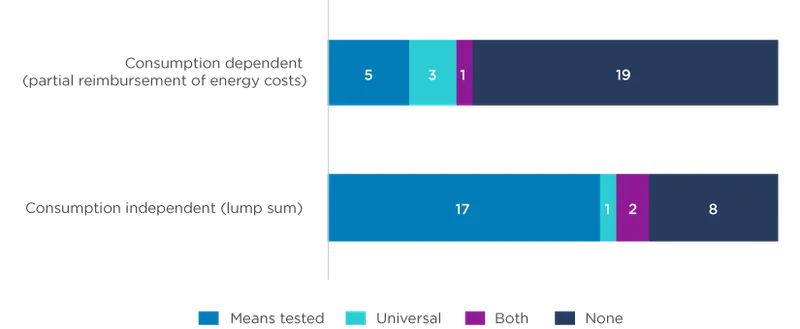
Source: Bruegel, National fiscal policy responses to the energy
crisis, 21 October 2022, accessed at Bruegel.
Cash transfers (lump sum payments)
The initial response of many European countries to the energy
price rises was to provide cash transfers to households, whether
targeted at more vulnerable households, or available to
everyone.10 For instance, in February 2022, the UK
government announced a package of measures that promised most
households payments of £350 to help pay their energy and
housing tax bills.11 Similarly, in March 2022, the
German government agreed an expanded set of measures to help with
energy prices, including one-off tax relief payments of €300,
and an extra €100 for families on social
benefits.12
Cash transfers have many advantages – they can be targeted
at vulnerable households, typically have low administrative burdens
and are quick to implement. They do not distort the operation of
the energy market, meaning that they maintain incentives on
households to reduce demand in response to high prices.
However, this can also be seen as the major downside of cash
transfers. Because they are not linked to consumption, they do not
reflect how high prices affect households in practice. A household
in a well-insulated modern apartment in a warm part of the country
might receive the same cash transfer as one in a poorly-insulated
old house that is frequently exposed to very cold weather. The
sense that the scale of earlier measures was insufficient to
respond to the needs of some households has been an important
driver of governments’ willingness in recent months to
implement measures that subsidise energy costs directly.
Universal subsidies linked to energy consumption
Another option can be a universal subsidy linked to energy
consumption for all households and businesses.
In Europe, partial reimbursement of energy costs has been
implemented in Cyprus, Greece, Portugal and Sweden.13 A
price cap, setting the maximum amount that suppliers are permitted
to charge per unit of energy consumed, has been introduced or
modified in 2022 in Austria, Czechia, Estonia, Hungary, Lithuania,
Montenegro, the Netherlands, Slovenia, Slovakia and the United
Kingdom.14 For instance, in the United Kingdom, the
pre-existing price cap for gas and electricity rose to an
annualised level of £4,279 in January 2023, but bill-payers
were protected from much of this rise under the government’s
Energy Price Guarantee, which limited the annualised bill for a
house with typical consumption to £2,500 – from April,
the Energy Price Guarantee will increase to
£3,000.15 Suppliers are typically reimbursed, in
whole or in part, for the difference between the costs they incur
and the amount they can charge consumers. Similarly, Bulgaria,
France and Luxembourg have implemented freezes of the regulated
price, or limited increases below what might have been
expected.16 For instance, in France in 2021, the Prime
Minister promised to limit the increase in regulated tariffs to 4%
for the whole of 2022.17 For 2023, regulated tariffs can
increase by up to 15%.18
This universal subsidy approach eases the affordability problem
for consumers, but can be very expensive. The International
Monetary Fund estimates that untargeted distortionary measures,
largely universal subsidies, will on average cost European
countries around 0.8% of GDP in 2022/23, more than half of the
total fiscal cost of energy support measures.19
Figure 4: Impact of universal subsidies
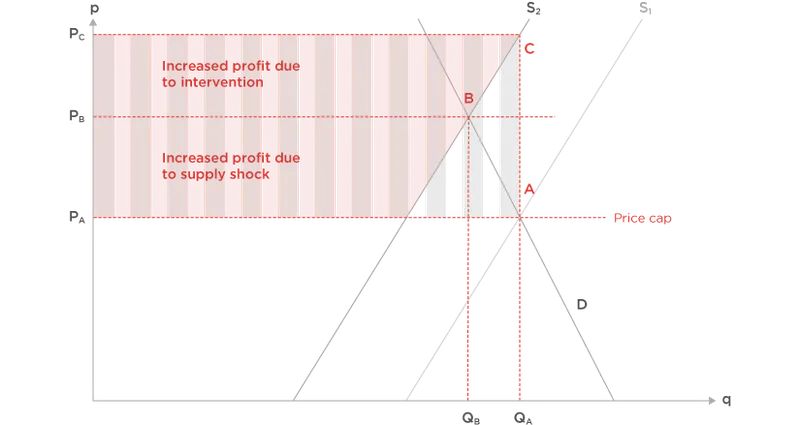
At an appropriate scale, a universal subsidy scheme can
dramatically improve affordability for consumers, and reduce the
risks of serious hardship. But it is a blunt tool, which can
introduce several other risks.
The subsidy measure increases the cost of the intervention
because it blunts the incentives to reduce demand. To an extent,
that is intended, in order to reduce hardship, but the universal
scope of the subsidy also reduces incentives to cut back on the
proportion of energy consumption that consumers would have been
willing and able to give up if they had faced higher prices.
As a result, the price that the government pays for energy will
be even higher than market prices in the absence of intervention,
as is illustrated in Figure 4. At the capped price of
PA, consumers wish to consume QA units of
energy – the same as they were consuming before the supply
shock. But higher prices are required to bring forward this amount
of energy. The market price rises to PC, which is the
corresponding price for QA on the new supply curve
S2. Energy providers thus receive even higher profits,
and the government pays the difference between PA and
PC (grey shaded area).
In principle, “windfall” taxation of energy company
profitability could limit the scale of this impact, and reduce the
fiscal costs governments face. The European Council agreed levies
on energy company profitability in September 2022, 20
and taxes on windfall profits have been implemented or extended in
several European countries during 2022: the Netherlands in
September, Romania in October, Cyprus, Greece, Ireland, Italy, the
United Kingdom and Czechia in November, and Germany and Portugal in
December.21 Well-designed windfall taxes could transfer
some of the surplus resulting from the energy supply shock away
from firms and towards consumers or taxpayers. It is, though,
important to ensure that the implementation of windfall taxes does
not further reduce energy supply, and that any impacts on long-term
energy investment are minimised.
Moreover, universal subsidies can increase the risk that
administrative rationing will be needed to mitigate the pressure on
supply, for instance in the event of higher than expected demand
due to a particularly cold winter, or a further constraint in
supply. This can be seen in Figure 5, where at the capped price
PA, consumers demand QA, which, due to an
additional shock, supply can no longer meet at any reasonable
price. In this case, administrative rationing is required to ensure
demand falls to a level that can be supplied
(Qc).22
Figure 5: Risk of rationing of supply
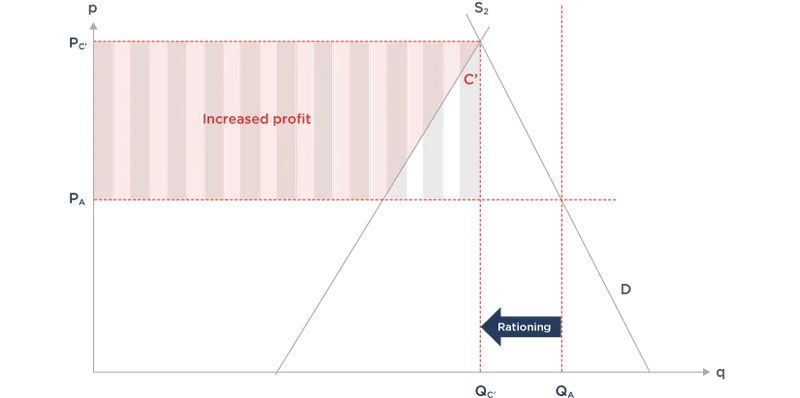
The possibility of rationing has been discussed in several
European countries, though fortunately no significant
administrative rationing has been needed so far.23 If
required, such administrative rationing can have significant
negative consequences, since it is very difficult to estimate which
energy uses are of highest value without price signals. Rationing
can also encourage rent-seeking behaviour, whereby firms try to
gain privileged access to the rationed supply.24
Targeted subsidies linked to energy consumption
An alternative approach to mitigate the effects of the supply
shock is to subsidise the prices paid by some groups of consumers.
The targeted group of consumers can take various forms: for
instance, it could be households rather than businesses, or those
households or businesses assessed as vulnerable.
In Europe, means-tested partial reimbursement of energy costs
for households has been implemented in Belgium, Greece, Italy,
Lithuania, Romania and Spain.25 In October 2022, the
Spanish government announced the creation of a
“temporary” new category of electricity consumers (1.5
million households) entitled to a 40% discount on their bills. For
businesses, the Irish government will provide eligible businesses
with compensation of 40% of the increase in their energy bills (gas
and electricity), capped at €10,000 a month.26 In
France, support for small and medium-sized enterprises, initially
covering 25% of their consumption, was announced in October
2022.27
We can extend the setting above to consider the expected impacts
of such subsidies on market outcomes, as illustrated in Figure 6.
In this diagram, the price PB and the supply curve
S2 are the same as in Figure 2 – they show energy
supply following a cut-off in Russian gas supplies, and the price
that would be charged without intervention. But demand is split
between two groups, R (regulated prices) and M (market prices) (we
can think of these as domestic and business consumers, or
vulnerable groups and other consumers), with demand curves
DR and DM. We assume that the demand curve is
more steeply sloped for group R, reflecting for instance the
expectation that domestic demand is more inelastic in the short
term than business demand.
Figure 6: Targeted subsidies for domestic
consumers
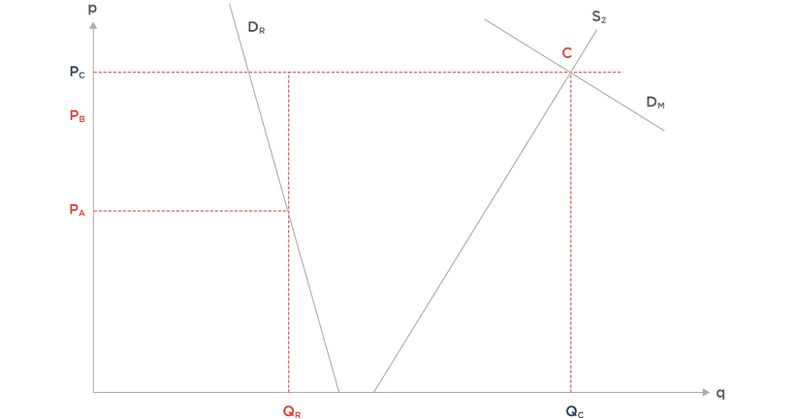
The left-hand part of the figure shows outcomes for consumers
with regulated prices, which we assume to be capped at
PA, the price before the supply shock. They consume
quantity QR at this price, more than they would have
done at PB. As a consequence, prices increase for
everyone else, to a level higher than they would have faced without
intervention. In the right-hand part of the figure, the curve
DM shows demand from consumers exposed to market prices.
Market prices are not capped, so prices are determined by the
intersection between the demand and supply curves, at point C.
Overall market prices are PC, while the total quantity
of energy consumed is QC. Note that PC is
higher than PB (and QC is greater than
QB). This is because consumers facing regulated prices
have no incentive to reduce their demand. Instead, all demand
reduction comes about through the group of consumers exposed to
market prices, and higher prices are therefore required to achieve
the same level of demand reduction. The untargeted group faces the
burden both of higher prices and of energy-saving efforts.
Figure 7 displays the welfare consequences of this intervention.
As a result of the supply shock, suppliers’ profits increase by
the sum of areas 1, 2, 3 and 4. Areas 1 and 2 are the same as the
red shaded area in Figure 2 (as the price increased from
PA to PB). However, area 1 is now paid for by
the fiscal authority, rather than by consumers. Areas 3 and 4
represent additional profits for firms, due to the increase in
prices following the subsidies. Area 3 is paid for by the fiscal
authority, while area 4 is paid for by consumers exposed to market
prices.
Figure 7: Welfare consequences of targeted
subsidies
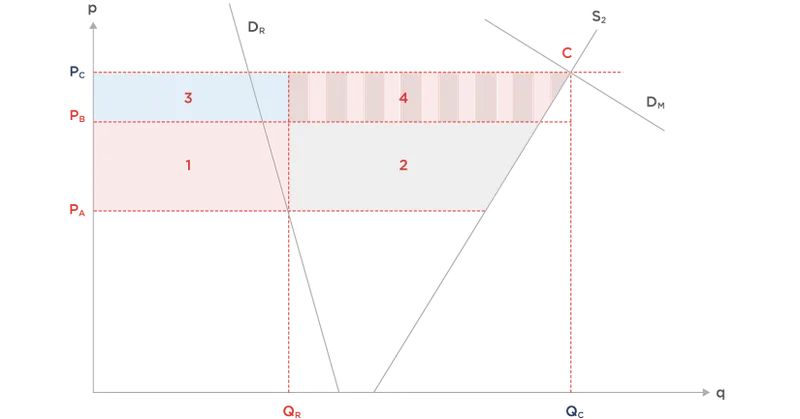
Therefore, relative to the situation without intervention,
supplier profits are higher and consumers with regulated prices are
better off, while the fiscal authority and consumers exposed to
market prices are worse off. In addition, unlike in Figure 2, we
observe some inefficiency – there are consumers with
regulated prices who would be prepared to sell some of their energy
to unprotected consumers at prevailing market prices.
These effects will be larger when the group of subsidised
consumers is greater and when the demand of the subsidised
consumers is more elastic (as this means more of the burden of
adjustment will be borne by unprotected consumers).
The best of both worlds: core consumption subsidies?
The effects explained in Section 5 bring further insights for
considering another type of targeted subsidy, in which support is
targeted like a progressive income tax schedule. Consumers can buy
a given amount of energy at a low price, then a further block at a
higher price, and then consumption is exposed to market prices. The
objective of this approach is to ensure that consumers are able to
cover their essential needs, such as core heating, but there are
strong incentives to reduce consumption at the margin. In
principle, this could mean that there is little or no
price-increasing effect of the subsidy, because consumer demand is
not increased. Risks of administrative rationing should also be
greatly reduced because consumers are still exposed to market
prices. Moreover, even though the subsidy can be applied to all
consumers, it is less costly than the universal subsidy discussed
in Section 4 as it applies to only a proportion of energy
consumption.
Approaches of this kind have been adopted by some European
governments. For instance, both Austria and the Netherlands have
introduced price caps on the first 2900 kWh of a household’s
electricity consumption. In Croatia, there is a low price cap on
consumption up to 2500 kWh, followed by a higher cap on additional
consumption. Schools, kindergartens, universities, old people’s
homes, NGOs, and administrative buildings pay a fixed price. Greece
has implemented a subsidy along with household-specific incentives
to reduce demand; consumers who cut their average daily consumption
by 15% year on year receive a 50 euro subsidy per MWh
consumed.28
Such policies hold out the hope of an appealing mix of
government support for energy consumption that is really needed,
good incentives on consumers to reduce demand in response to the
supply shock, and relatively limited fiscal costs. However, it is
always difficult to ensure that subsidies of this kind are targeted
at those consumers that need them. For instance, larger households
will typically have higher intrinsic energy needs, as will those in
cold areas or poorly insulated houses – often private renters
who have limited control over their energy efficiency. Moreover,
longer term these policies could create risks of gaming by
consumers, such as by dividing up households artificially to
benefit from consumption subsidies.
The trade-offs involved in subsidising energy consumption can be
seen in Figure 8, created by the World Bank economist Nithin
Umapathi. In this framework, the ideal approach would follow the
red line, with high levels of assistance for the poorest groups,
gradually tapering off as income increases. But in practice,
governments face a trade-off between targeting assistance narrowly,
as in the orange box, which could miss out lower to middle-income
households, or providing broad-based support, which may be
insufficient for the poorest groups. It should be noted, however,
that while this framework is complicated enough in itself,
governments will typically care about multiple dimensions of energy
need, including for instance age and health status as well as
income.
Figure 8: No subsidy scheme is likely to target
consumers optimally

Source: Brookings, How to help people in Europe and Central Asia
pay their energy bills, October 2022
Preparing for next winter and beyond
Overall, the scale and nature of European governments’
subsidies to energy demand can be seen as a reasonable reaction to
a crisis situation that posed a serious threat to living conditions
and well-being across the continent. However, as this article has
shown, they have not come without costs. Subsidies have reduced the
incentives on consumers to cut their demand, meaning that prices
have risen still further and that the risks of administrative
rationing have increased. Subsidies have boosted the already
elevated profits of energy companies, at least in the absence of
windfall taxation. The fiscal costs are also non-trivial; in
November 2022, Bruegel estimated that Germany had committed 7.4% of
its GDP to energy support measures, more than €260
billion.29
Beyond the issues covered here, there are also some wider
economic risks of the interventions we have seen. This article has
examined outcomes in a single energy market with a single
government deciding whether to introduce subsidies. In reality,
international energy markets are closely interlinked, particularly
within Europe. This means that energy subsidies could have a
snowball effect across markets. Subsidies in one country tend to
increase prices both in that country and in neighbouring markets
– potentially increasing the pressure for subsidies in
neighbouring countries too. Moreover, because gas is priced in
dollars, subsidy schemes in practice involve governments taking on
substantial liabilities denominated in a foreign currency, with
potential risks for perceived fiscal sustainability.
While energy prices have fallen somewhat recently, there is
unlikely to be a quick fix to the problems faced by European
countries. This means that policymakers should consider how future
energy support schemes can be designed more smartly, with the twin
objectives of providing support for essential use, particularly by
vulnerable groups, and maintaining effective signals for reducing
demand over time, through prices and other methods. This may
include moving back to lump sum transfers that are not linked to
energy consumption, or concentrating subsidies on core consumption
only.
In the long run, the crisis has further suggested that the
energy trilemma – the apparent trade-off between
affordability, energy security, and decarbonisation – is no
more. One of the tragic ironies of the current situation is that
some environmental policies that countries postponed because they
were too expensive, such as energy efficiency measures, might have
easily paid for themselves in recent years.30 The
striking progress in reducing the costs of low-carbon generation
such as wind and solar creates great opportunities for improving
all three arms of the trilemma over time, with more affordable
green energy that is less subject to global geopolitical
developments.
Footnotes
1 European Commission, Opening remarks by Executive
Vice-President Timmermans and Commissioner Simson at the press
conference on an emergency intervention to address high energy
prices, September 2022, accessed at European Commission.
2 Joe Perkins is a Senior Vice President and the Head of
Research at Compass Lexecon. Clemence Rainaut is an Analyst at
Compass Lexecon. The views expressed in this article are the views
of the authors only and do not necessarily represent the views of
Compass Lexecon, its management, its subsidiaries, its affiliates,
its employees or its clients.
3 Longer term, prices also affect incentives to invest in
producing a good, and they influence the allocation of resources
across different markets.
4 See Eurostat, “Annual inflation up to 10.6% in the
euro area, European Commission”. Available at: https://ec.europa.eu/eurostat/documents/2995521/15265521/2-17112022-AP-EN.pdf/b6953137-786e-ed9c-5ee2-6812c0f8f07f.
Accessed 3 February 2023.
5 European Commission, Opening remarks by Executive
Vice-President Timmermans and Commissioner Simson at the press
conference on an emergency intervention to address high energy
prices, September 2022, accessed at European Commission.
6 Typical estimates of price elasticity of demand
consumers are around -0.1. That is, demand falls by around 1% for
every 10% increase in prices. See, for instance, https://assets.publishing.service.gov.uk/government/uploads/system/uploads/attachment_data/file/532539/Annex_D_Gas_price_elasticities.pdf.
7 This green area can be taken to represent the lost
profits of those suppliers who are no longer in the market after
the supply shock – for instance, Russian gas
suppliers.
8 If demand and supply were more elastic, quantities
would change more, but prices and profits would change
less.
9 NHS Confederation, Could the energy crisis cause a
public health emergency? 2022, accessed at NHS.
10 We term as “cash transfers” measures that
provide money to households that is not linked to the level of
their energy consumption. In practice, these measures provide money
in various ways, particularly through the tax or benefit
systems.
11 See https://www.gov.uk/government/news/millions-to-receive-350-boost-to-help-with-rising-energy-costs.
12 See https://www.dw.com/en/germany-unveils-measures-to-tackle-high-energy-prices/a-61243572.
13 Bruegel, National fiscal policy responses to the
energy crisis, 21 October 2022. Available at: https://www.bruegel.org/dataset/national-policies-shield-consumers-rising-energy-prices.
14 Bruegel, National fiscal policy responses to the
energy crisis, 21 October 2022, Available at: https://www.bruegel.org/dataset/national-policies-shield-consumers-rising-energy-prices.
15 See https://www.ofgem.gov.uk/publications/latest-energy-price-cap-announced-ofgem.
The Energy Price Guarantee (EPG) reduces the unit cost of
electricity and gas that consumers pay. The EPG will increase so
that the bill for a consumer with typical consumption paying by
direct debit will be £3,000 (expressed in annualised terms),
compared with £2,500 – which was the maximum level up
to 31 Match 2023. In addition, there are cost-of-living payments of
£900 for those on means tested benefits, £300 to
pensioners, £150 to those on disability benefits and doubling
support for those on LPG or heating oil.
16 Bruegel, National fiscal policy responses to the
energy crisis, 21 October 2022, Available at: https://www.bruegel.org/dataset/national-policies-shield-consumers-rising-energy-prices.
19 See https://www.imf.org/en/Publications/fandd/issues/2022/12/helping-europe-households-Celasun-Iakova.
20 See https://www.bbc.co.uk/news/business-63089222.
21 Bruegel, National fiscal policy responses to the
energy crisis, 29 October 2022, accessed at Bruegel.
22 Alternative energy saving approaches can help to
mitigate the effects of subsidies on increasing demand. For
instance, in September 2022 Germany implemented measures including
a ban on retail stores keeping their doors open and limitations on
the heating of public buildings, with the hope that they would
reduce gas consumption by around 2%. See https://www.dw.com/en/germanys-energy-saving-rules-come-into-force/a-62996041.
23 See https://www.reuters.com/business/energy/germany-might-consider-gas-rationing-uniper-ceo-2022-09-05/.
24 Bulow and Klemperer, Regulated prices, rent-seeking,
and consumer surplus, 2012, accessed at Bulow and Klemperer.
25 Bruegel, National fiscal policy responses to the
energy crisis, 21 October 2022, accessed at Bruegel.
26 Bruegel, National fiscal policy responses to the
energy crisis, 21 October 2022, accessed at Bruegel.
27 See https://www.economie.gouv.fr/hausse-prix-energie-renforcement-dispositifs-aides-entreprises.
28 See Bruegel, National fiscal policy responses to the
energy crisis, 21 October 2022, accessed at Bruegel, and https://www.europarl.europa.eu/RegData/etudes/STUD/2022/699535/IPOL_STU(2022)699535_EN.pdf.
29 See https://www.bruegel.org/dataset/national-policies-shield-consumers-rising-energy-prices.
30 See, e.g., https://www.newstatesman.com/environment/2022/03/why-cant-the-uk-manage-to-insulate-its-homes.
Originally published 22 February 2023
The content of this article is intended to provide a general
guide to the subject matter. Specialist advice should be sought
about your specific circumstances.

